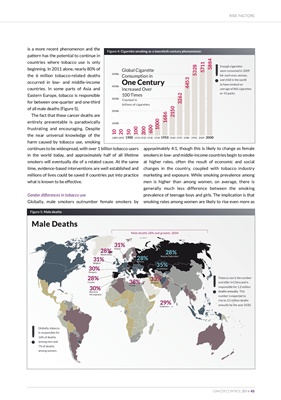
RISK FACTORS
46 CANCER CONTROL 2014
teenage female smokers continue their addiction as adults. In
fact, securing youth smokers in this way is a survival strategy
of the tobacco industry, as most adult smokers begin their
addiction before the age of 18. Of significant concern are lowand middle-income countries in which the smoking rates
of
teenage boys are alarmingly high; in some countries, virtually
half of all boys aged 13-15 are smokers (Figure 6).
The tobacco industry
The global tobacco industry represents big business. Tobacco
is grown in at least 124 countries in the world and is grown on
more than 3.8 million hectares of agricultural land. Tobacco is
grown with little benefit to farmers, who are often trapped in
a cycle of poverty and are victims of farming-related illness
from exposure to tobacco leaves and nicotine. Additionally,
tobacco is grown on land that could be used for other food
products, and in 2009, six of the world's top 10 tobaccoproducing countries had undernourishment rates
between
5% and 27%. Tobacco companies and manufacturers are the
winners of tobacco production. In 2010, the six leading
tobacco companies in the world had combined revenues of
more than US$ 346 billion and combined profits over US$ 35
billion. These companies profit greatly from the addiction of
others and work diligently to keep customers as lifetime
addicts.
Tobacco marketing is one avenue of attracting and
maintaining tobacco users, and tobacco companies market
their products heavily. In 2008 in the United States, tobacco
companies spent more than US$ 9.9 billion on cigarette
marketing and an additional US$ 548 million on smokeless
tobacco marketing, equating to US$ 34 being spent on
tobacco marketing for every man, woman and child in the
United States. Marketing restrictions have increased in highincome countries, but many
low- and middle-income
countries do not have
tobacco marketing bans or
restrictions and adults and
children are exposed daily to
pro-tobacco propaganda and
messages (Figure 7).
Tobacco-related costs and
affordability of cigarettes
The results of the tobacco
epidemic are costly and
include both direct and
indirect costs to society. Direct medical costs are incurred to
treat tobacco-related illness and indirect costs include the
loss of labour productivity, pollution and other environmental
harm, and fire damage, not to mention the costs of human
suffering that victims and their families face. In some
countries, such as Egypt and Mexico, tobacco-related health
care costs exceed 10% of total health care expenditures.
Cigarette smokers in developing countries face personal
opportunity costs that can involve the sacrifice of basic needs
like food and education to satisfy their addictions. Cigarette
prices vary widely from country to country with a tendency
toward more affordability in low- and middle-income
countries (Figure 8), with "affordability" expressed as a
percentage of income or duration of work time it takes to
purchase a product. The fact that cigarettes may be more
affordable compounds the problem, as low costs make it
easier for smokers to justify the purchase of cigarettes over
basic necessities. Essentially, increases in cigarette
affordability confound tobacco control efforts.
Countries With the Highest
Smoking Rates Among Boys
Ages 13-15, 2011 or latest available
30.7%Madagascar
33.8%Lithuania 36.3%Latvia
36.3%Malaysia
36.9%Fed. States of Micronesia
33.2%Tuvalu
37.5%Tonga
52.1%Papua New Guinea
50.6%Timor-Leste
31.0%Palau
31.2%Belarus
Africa Europe Western Pacific
South-East Asia
Figure 6: Countries with the highest smoking rates among boys
"If you're not allowed it, but you
really want it, then you can have it!"
Advertisement slogan for Kiss Cigarettes in Russia, 2011
Figure 7: Pro-tobacco propaganda